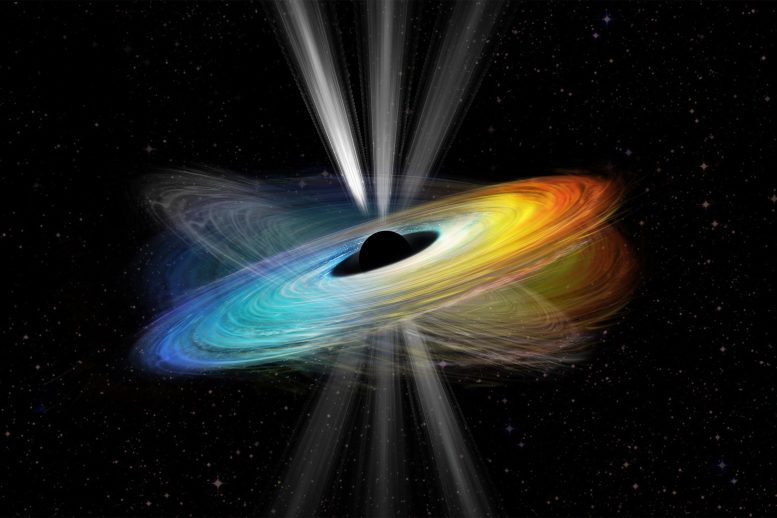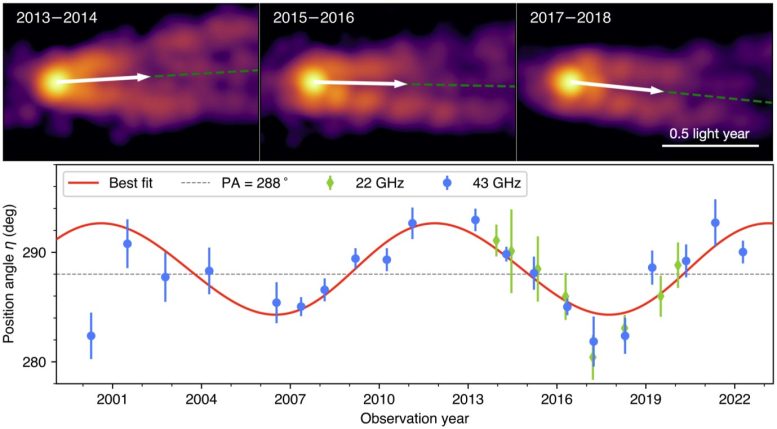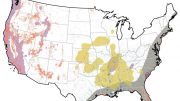
Schematic representation of the tilted accretion disk model. The black hole spin axis is assumed to be straight up and down in this illustration. The jet direction points almost perpendicular to the disk plane. The misalignment between the black hole spin axis and disk rotation axis triggers the precession of the disk and jet. Credit: Yuzhu Cui et al. (2023), Intouchable Lab@Openverse and Zhejiang Lab
The M87 galaxy’s black hole exhibits an oscillating jet, confirming its spin, as deduced from a two-decade study aligning with Einstein’s General Theory of Relativity predictions.
The nearby radio galaxy M87, located 55 million light-years from the Earth and harboring a black hole 6.5 billion times more massive than the Sun, exhibits an oscillating jet that swings up and down with an amplitude of about 10 degrees, confirming the black hole’s spin.
The study, which was headed by Chinese researcher Dr. Yuzhu Cui and published in Nature on September 27, was conducted by an international team using a global network of radio telescopes.
“This monster black hole is indeed spinning.” — Dr. Kazuhiro Hada
Through extensive analysis of telescope data from 2000–2022, the research team revealed a recurring 11-year cycle in the precessional motion of the jet base, as predicted by Einstein’s General Theory of Relativity. The study links the dynamics of the jet with the central supermassive black hole, offering evidence that M87’s black hole spins.
Supermassive Black Hole Phenomena
Supermassive black holes at the center of active galaxies—the most disruptive celestial objects in our universe—can accrete tremendous amounts of material due to the extraordinary gravitational force and power of plasma outflows, known as jets, that approach the speed of light and extend thousands of light-years away.
The energy transfer mechanism among supermassive black holes and their accretion disks and relativistic jets has puzzled physicists and astronomers for over a century. A prevailing theory suggests that energy can be extracted from a spinning black hole, allowing some material surrounding the supermassive black hole to be ejected with great energy. However, the spin of supermassive black holes, a crucial factor in this process and the most fundamental parameter other than black hole mass, had not been directly observed.

Top panel: M87 jet structure at 43 GHz based on bi-yearly stacking data observed from 2013–2018. The white arrows indicate the jet position angle in each subplot. Bottom panel: Best fitted results based on the yearly stacked image from 2000–2022. The green and blue points were obtained from observations at 22 GHz and 43 GHz, respectively. The red line represents the best fit according to the precession model. Credit: Yuzhu Cui et al., 2023
Focus on M87
In this study, the research team focused on M87, where the first observational astrophysical jet was observed in 1918. Thanks to its proximity, the jet formation regions close to the black hole can be resolved in detail with Very Long Baseline Interferometry (VLBI), as represented by recent black hole shadow imaging with the Event Horizon Telescope (EHT). By analyzing VLBI data from M87 obtained over the last 23 years, the team detected the periodic precessional jet at its base, offering insight into the status of the central black hole.
Black Hole Dynamics and Relativity
At the heart of this discovery lies the critical question: What force in the universe can alter the direction of such a powerful jet? The answer could be hidden in the behavior of the accretion disk, a configuration related to the central supermassive black hole.
As infalling materials orbit the black hole due to their angular momenta, they form a disk-like structure before gradually spiraling inwards until they are fatefully drawn into the black hole. However, if the black hole is spinning, it exerts a significant impact on surrounding spacetime, causing nearby objects to be dragged along its axis of rotation, a phenomenon known as “frame-dragging,” which was predicted by Einstein’s General Theory of Relativity.
“We are thrilled by this significant finding.” — Yuzhu Cui
The research team’s extensive analysis indicates that the rotational axis of the accretion disk misaligns with the black hole’s spin axis, leading to a precessional jet. Detecting this precession provides unequivocal evidence that the supermassive black hole in M87 is indeed spinning, thus enhancing our understanding of the nature of supermassive black holes.
“We are thrilled by this significant finding,” said Yuzhu Cui, a postdoctoral researcher at Zhejiang Lab, a research institution in Hangzhou, and lead and corresponding author of the paper. “Since the misalignment between the black hole and the disk is relatively small and the precession period is around 11 years, accumulating high-resolution data tracing M87’s structure over two decades and thorough analysis are essential to obtain this achievement.”
“After the success of black hole imaging in this galaxy with the EHT, whether this black hole is spinning or not has been a central concern among scientists,” added Dr. Kazuhiro Hada from the National Astronomical Observatory of Japan. “Now anticipation has turned into certainty. This monster black hole is indeed spinning.”
Contributions and Future Implications
This work made use of a total of 170 epochs of observations obtained by the East Asian VLBI Network (EAVN), the Very Long Baseline Array (VLBA), the joint array of KVN and VERA (KaVA), and the East Asia to Italy Nearly Global (EATING) network. In total, more than 20 telescopes across the globe contributed to this study.
Radio telescopes in China also made contribution to this project, including China’s Tianma 65-meter radio telescope with its huge dish and high sensitivity at millimeter wavelengths. In addition, Xinjiang 26-meter radio telescope enhances the angular resolution of EAVN observations. The good quality data with both high sensitivity and high angular resolution are essential to obtain this achievement.
“The in-building Shigatse 40-meter radio telescope by Shanghai Astronomical Observatory, will further improve the imaging capability of EAVN at millimeters. Especially, the Tibetan Plateau, where the telescope is located, owns one of the most excellent site conditions for (sub-)millimeter wavelength observations. It fulfills our expectations to promote domestic sub-millimeter facilities for astronomical observations,” said Prof. Zhiqiang Shen, Director of the Shanghai Astronomical Observatory of the Chinese Academy of Sciences.
While this study sheds light on the mysterious world of supermassive black holes, it also presents formidable challenges. The accretion disk’s structure and the exact value of the M87 supermassive black hole’s spin are still highly uncertain. This work also predicts that there will be more sources with this configuration, thus challenging scientists to discover them.
Reference: “Precessing jet nozzle connecting to a spinning black hole in M87” by Yuzhu Cui, Kazuhiro Hada, Tomohisa Kawashima, Motoki Kino, Weikang Lin, Yosuke Mizuno, Hyunwook Ro, Mareki Honma, Kunwoo Yi, Jintao Yu, Jongho Park, Wu Jiang, Zhiqiang Shen, Evgeniya Kravchenko, Juan-Carlos Algaba, Xiaopeng Cheng, Ilje Cho, Gabriele Giovannini, Marcello Giroletti, Taehyun Jung, Ru-Sen Lu, Kotaro Niinuma, Junghwan Oh, Ken Ohsuga, Satoko Sawada-Satoh, Bong Won Sohn, Hiroyuki R. Takahashi, Mieko Takamura, Fumie Tazaki, Sascha Trippe, Kiyoaki Wajima, Kazunori Akiyama, Tao An, Keiichi Asada, Salvatore Buttaccio, Do-Young Byun, Lang Cui, Yoshiaki Hagiwara, Tomoya Hirota, Jeffrey Hodgson, Noriyuki Kawaguchi, Jae-Young Kim, Sang-Sung Lee, Jee Won Lee, Jeong Ae Lee, Giuseppe Maccaferri, Andrea Melis, Alexey Melnikov, Carlo Migoni, Se-Jin Oh, Koichiro Sugiyama, Xuezheng Wang, Yingkang Zhang, Zhong Chen, Ju-Yeon Hwang, Dong-Kyu Jung, Hyo-Ryoung Kim, Jeong-Sook Kim, Hideyuki Kobayashi, Bin Li, Guanghui Li, Xiaofei Li, Zhiyong Liu, Qinghui Liu, Xiang Liu, Chung-Sik Oh, Tomoaki Oyama, Duk-Gyoo Roh, Jinqing Wang, Na Wang, Shiqiang Wang, Bo Xia, Hao Yan, Jae-Hwan Yeom, Yoshinori Yonekura, Jianping Yuan, Hua Zhang, Rongbing Zhao and Weiye Zhong, 27 September 2023, Nature.
DOI: 10.1038/s41586-023-06479-6









Resembles multiple engines on a rocket, so it seems multiple sources are involved.
Exactly what is spinning when a black hole is said to be spinning?
Peter Aretin, the BH itself is spinning; i.e., everything within the event horizon. It’s not surprising given the conservation of momentum and hte fact everything falling into a BH has momentum.
A multiply-gapped accretion disk is being invoked to explain the images. I’d think a single source of a helically-shaped beam would have obvious staggering on opposite sides, but here I see indications of two opposing coupled helix pattern generators. Suppose two compact oppositely spinning gravity sources where spinning encourages a strong accretion disk, and one can end up with mechanism for maintaining a tight spacing that is fairly stable, similar to two battle-tops dancing in a very shallow bowl.